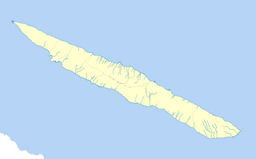Ponta dos Rosais
| Ponta dos Rosais | |
| Headland (Ponta) | |
|
An expansive view of Ponta dos Rosais, on the tip of the island of São Jorge
|
|
| Official name: Ponta dos Rosais | |
| Named for: Rosais | |
| Country | |
|---|---|
| Autonomous Region | |
| Islands | Eastern Group |
| Location | Azores Platform, Mid-Atlantic Ridge, Atlantic Ocean |
| Municipalities | Velas |
| Landmark | Lighthouse of Rosais |
| Coordinates | 38°45′20″N 28°19′1″W / 38.75556°N 28.31694°WCoordinates: 38°45′20″N 28°19′1″W / 38.75556°N 28.31694°W |
| Biomes | Temperate, Mediterranean |
| Geology | Alkali basalt, Tephra, Trachyte, Trachybasalt |
| Orogeny | Volcanism |
| Period | Holocene |
| Geographic detail from Portuguese Army map | |
Ponta dos Rosais (Rosais Point) is a promontory located along the north coast of the parish of Rosais, municipality of Velas in the island of São Jorge in the Portuguese archipelago of the Azores.
The promontory of Ponta dos Rosais is situated on a 200 metres (660 ft) above the waters of the Atlantic on the northern tip of the island of São Jorge. With a view to the distant islands of Faial, Pico and Graciosa, little more than 15 kilometres (9.3 mi) from the point, and extends north-northwest from the small islet of Rosais towards the Baixa da Ponta dos Rosais.
On the promontory is the isolated, mid-century Nationalist, lighthouse complex of Ponta dos Rosais.
This nature reserve and natural monument stretches the coastal cliffs from Pico dos Cutelos (along the southern coast) to northern cliffs and pasturelands of Chã do Areeiro. The reserve includes the waters surrounding the point, the islet of Rosais, Ponta da Ilha and Torrão da Açucar, as well as the Fajã do Mata Sete, an area of basalt rocks, stacks and mixture of pyroclastic flow and erosional debris. There are treacherous trails and alternative routes that link these zones, most skirting the coastal seashore.
The uplands are primarily pasture-land and agricultural areas, with most of the region taken-up by rural activities. Tourists visiting the area are attracted by the diversity of migratory and maritime bird species that nest in the cliffs of the point, including the migratory Corey's Shearwater (Calonectris diomedea) and Little shearwater (Puffinus assimilis), but also the Roseate (Sterna dougallii) and Common Terns (Sterna hirundo).
...
Wikipedia


